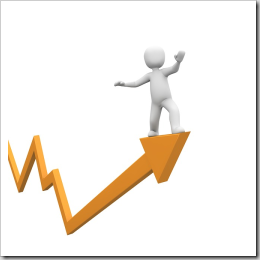 In 2021, at the height of the COVID-19 pandemic during which Australia’s two most populous cities spent long weeks under conditions of strict lockdown, the number of Australian standard patent applications filed by Australian resident applicants jumped by over 25%, to levels unseen since a rush on filings prompted by the Raising the Bar patent law reforms in 2013. While there may have been a number of contributing factors, including the phase-out of the second tier innovation patent system in August 2021, it is nonetheless fair to say that there was no indication of any downturn in Australian filings as a result of the pandemic.
In 2021, at the height of the COVID-19 pandemic during which Australia’s two most populous cities spent long weeks under conditions of strict lockdown, the number of Australian standard patent applications filed by Australian resident applicants jumped by over 25%, to levels unseen since a rush on filings prompted by the Raising the Bar patent law reforms in 2013. While there may have been a number of contributing factors, including the phase-out of the second tier innovation patent system in August 2021, it is nonetheless fair to say that there was no indication of any downturn in Australian filings as a result of the pandemic.
So what about international applications under the Patent Cooperation Treaty (PCT)? Filing a PCT application is generally a more costly exercise than filing a domestic application, and usually signals the applicant’s intent to proceed with national applications in multiple countries. Therefore the number of PCT applications filed might be a better indicator of the economic impact of the pandemic on innovative Australian businesses and institutions. Unfortunately, information about a PCT application does not usually become publicly available until 18 months after the initial priority date which, in turn, is anywhere between six and 18 months after the PCT application itself was filed. As a result, it is only recently that it has become possible to observe any impact of the pandemic on PCT filings.
In this article, I present data on PCT filings by Australian resident applicants that have been published up until the end of August 2022, with numbers extrapolated for the full 2022 calendar year. What the data shows is that there has been no substantial effect, either positive or negative, on the total number of PCT applications filed annually by Australian residents since the start of the pandemic. Drilling down to the fields of technology covered by the applications filed, there are a number of ongoing trends that predate the pandemic. For example, applications relating to IT methods for management and civil engineering have continued pre-existing declines, while pharmaceuticals appear to be experiencing a period of growth. The one field in which there may be a specific pandemic-related effect is medical technology (e.g. devices and instruments), in which the number of published PCT applications has notably increased since 2020.
About the Data
All of the following charts depict numbers of PCT applications having at least one Australian resident applicant grouped by publication year. Note that this differs from my usual practice with Australian and New Zealand applications of plotting numbers against year of filing, because no information is available about any PCT application until it is published. In all cases (except in the rare event that an applicant requests early publication) an initial application establishing a priority date will have been filed 18 months prior to publication. Typically, the PCT application itself may have been filed at any time during the first 12 months of that 18 month period. For purposes of comparison, publication numbers for the full 2022 calendar year have been projected based on the first eight months of the year.
All of the publication data is further broken down according to the main field of technology with which each application is associated, based on the first International Patent Classification (IPC) code assigned to the application. These have been converted to corresponding technology sectors and fields using the IPC concordance table that has been developed by the World Intellectual Property Organization (WIPO). This table maps tens of thousands of individual IPC codes to a hierarchy of five sectors collectively covering 35 fields of technology.
Annual Publications by Technology Sector
The chart below shows the total number of PCT applications by Australian residents as published each year since 2002 further broken down into the five sectors defined in the IPC concordance table. (The ‘other fields’ sector comprises civil engineering, along with many household goods including furniture, many types of small appliances, and games.) As can be seen, use of the PCT system by Australian residents peaked in the mid-2000s, but fell in the wake of the Global Financial Crisis (GFC) of 2007-2009, after which it has stabilised, but never recovered to pre-GFC levels.
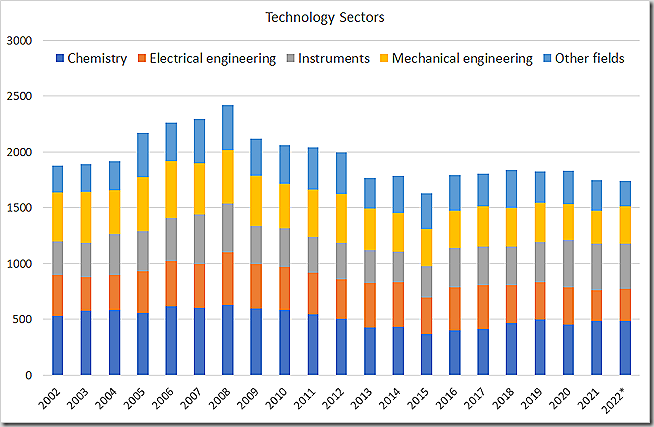
* Projected numbers based on publications to end of August 2022
There is no obvious sign in this data of any significant change in overall PCT filings that might be attributed with confidence to the pandemic. The slight drop in publications in 2021 could reflect a tightening of budgets for new filings during the early months of the pandemic. However, there were larger declines in 2009 (due to the GFC), 2013 (which might have been related to the commencement of the Raising the Bar patent law reforms in Australia), and 2015 (for which there is no obvious explanation), so any effect of the pandemic must be small relative to other events of the past two decades.
There are, however, some longer-term trends apparent in the data. When compared with the mid-2010s (e.g. 2013-2017), we can see that:
- the numbers of publications in the ‘chemistry’ and ‘instruments’ sectors have grown;
- the number of publications in the ‘mechanical engineering’ sector has remained relatively stable; and
- the numbers of publications in the ‘electrical engineering’ and ‘other’ sectors have declined.
This may reflect a shift in the Australian economy – or, at least, in the sectors of the economy in which the greatest investments in innovation and IP protection are occurring. However, patent filings are at best a proxy for economic activity, and I am reluctant to draw any firm conclusions in the absence of corroborating evidence.
Annual Publications in ‘Chemistry’ Sector
The following chart shows the number of PCT publications each year within the chemistry technology sector, further broken down into the corresponding 11 fields defined in the WIPO technology concordance.
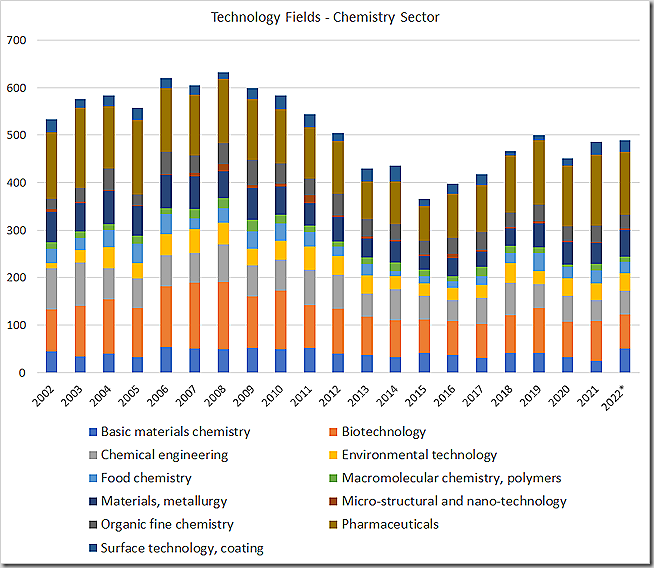
* Projected numbers based on publications to end of August 2022
Of the five technology sectors, chemistry has experienced the largest variation in PCT filings by Australian residents over the last 20 years. The number of publications at the low point in 2015 was barely above half the number at the high point in 2008. This has since recovered significantly, with publications in 2021 and 2022 back to around 80% of the level sustained throughout much of the 2000s.
However, publications in the field of biotechnology number only around 50% of where they were at their peak in 2007/2008. Australia generally considers itself to have a strong, and growing, biotechnology industry, and so these numbers are somewhat surprising. Whether they reflect a real decline in international patent filings by Australian biotechnology innovators, or a change in filing strategy – e.g. away from use of the PCT system towards a more targeted individual national filing approach – cannot be determined from this data alone.
On the other hand, publications in the field of pharmaceuticals have recovered strongly in recent years. The number of pharmaceutical publications each year since 2019 has returned to levels comparable to the mid-2000s. indeed, the number published in 2021 (149) was the highest since 2005 (157). This specific peak might have been influenced by the pandemic, however numbers have been consistently up since 2018, so it seems likely that there is also a longer-term trend at work here.
Annual Publications in ‘Electrical Engineering’ Sector
The following chart shows the number of PCT publications each year within the electrical engineering technology sector, further broken down into the corresponding eight fields defined in the WIPO technology concordance.
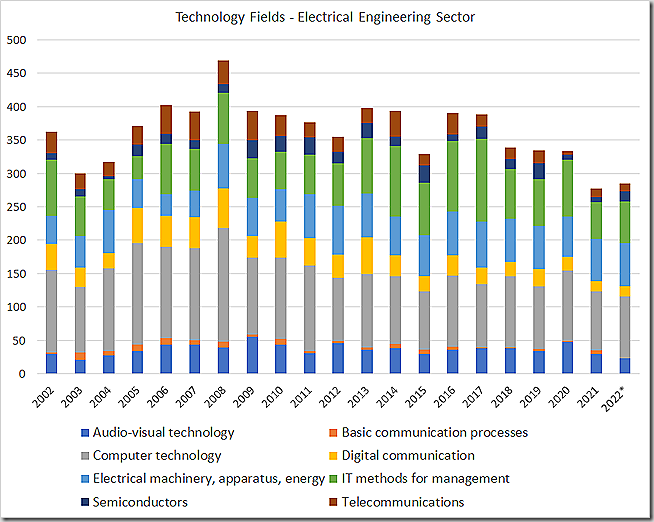
* Projected numbers based on publications to end of August 2022
Having originally qualified and worked as an electrical engineer myself, it is disappointing to see that PCT applications from Australia in this sector have generally been declining for many years. Publication numbers across all eight fields have peaked and fallen over the past two decades, although not all at the same time. Interestingly, publications in the field of ‘IT methods for management’ grew during the first half of the past decade, peaking in 2017 before declining significantly. This may reflect a growing recognition by applicants that this field encompasses subject matter characterised as ‘computer-implemented business methods’ that has increasingly been found to be unpatentable in a number of jurisdictions in recent years, including in Australia and the US.
There is no obvious indication that the pandemic has had any effect on PCT publications in this sector.
Annual Publications in ‘Instruments’ Sector
The following chart shows the number of PCT publications each year within the instruments technology sector, further broken down into the corresponding five fields defined in the WIPO technology concordance.
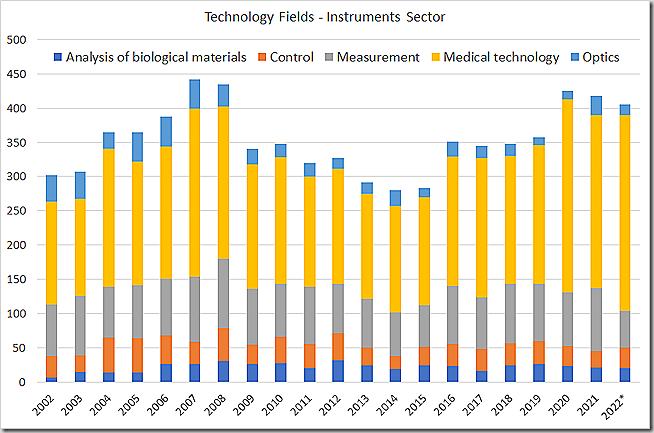
* Projected numbers based on publications to end of August 2022
A significant jump in publications in the field of medical technology in 2020 is difficult to ignore, and this has been sustained through to the current year. The original applications corresponding with publication in 2020 would have been filed in the first half of 2019 at the latest, and these initial filings could not have been influenced by the pandemic. However, the pandemic could have prompted some applicants to proceed with international applications as these became due during 2020 when they might otherwise not have done so. The number of PCT publications relating to medical technologies currently projected for 2022 is higher than ever before – including during the prior peak of 2007 – and this appears to be the result of a step change, rather than a longer-term trend. It is therefore possible that the pandemic has resulted in an increase in the number of PCT applications filed by Australian residents for inventions relating to medical technology.
Annual Publications in ‘Mechanical Engineering’ Sector
The following chart shows the number of PCT publications each year within the mechanical engineering technology sector, further broken down into the corresponding eight fields defined in the WIPO technology concordance.
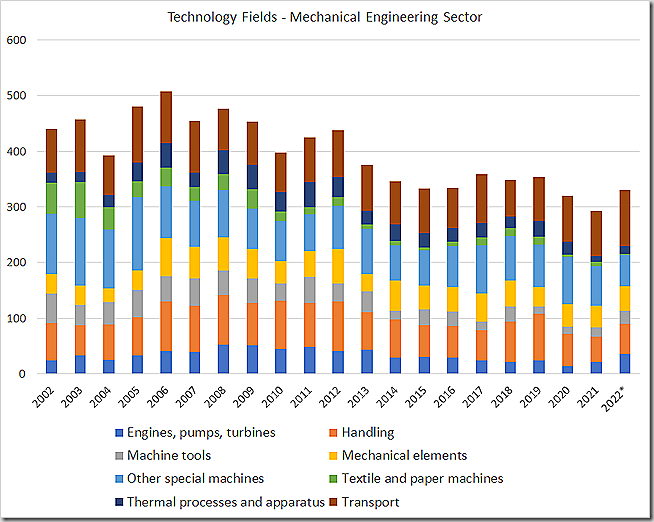
* Projected numbers based on publications to end of August 2022
While there has been a general decline in ‘mechanical engineering’ publications since the mid-2000’s, the overall numbers appear to have stabilised over the past decade. To the extent that there are any possible trends within the individual fields in this sector, there are signs of recent growth in engine, pump and turbine technology, and in transport. There is no evidence of any pandemic-induced effect.
Annual Publications in ‘Other’ Sector
The following chart shows the number of PCT publications each year within the ‘other’ technology sector, further broken down into the fields of civil engineering, furniture and games, and ‘other consumer goods’ (which encompasses many household appliances).
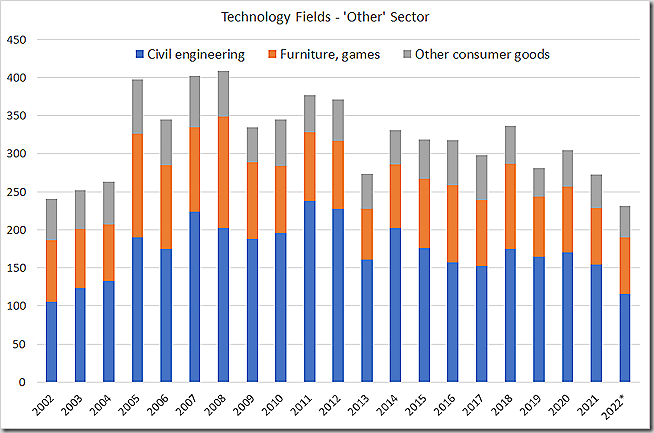
* Projected numbers based on publications to end of August 2022
It is notable that over the past two decades there has been less variation in the number of PCT publications relating to household goods (i.e. furniture, games and other consumer goods) than in the field of civil engineering. The overall decline in this sector over the last decade has been primarily due to falling numbers of civil engineering publications. The drop in publications over the past three years looks to be the continuation of a trend that has been ongoing for many years, unrelated to the pandemic.
Conclusion – Pandemic has had Minimal Impact on PCT Filings
Based on recent annual publication numbers, there is little indication that the pandemic has had any effect on the overall number of PCT filings made by Australian applicants. Indeed, total publication numbers have remained remarkably stable over the past decade, following a peak in 2008 and a subsequent decline following the GFC.
Drilling down, however, there are gains and losses in individual technology fields. Growth in publications in the chemistry and instruments sectors has been supported particularly by higher numbers of filings relating to pharmaceuticals and medical technology. On the other hand, applications relating to civil engineering have been declining, as have applications in the field of IT methods for management.
The only change that shows any sign of being correlated with the pandemic is a step increase in publications in the field of medical technology, which occurred in 2020 and has been sustained into 2021 and 2022. For the earlier publications, in particular, the innovation processes resulting in new patent applications would have commenced prior to the onset of the pandemic. Nonetheless, applicants with ongoing developments in medical technology may have increased PCT filings based on an increased awareness of the potential value of international patent protection in the face of a truly global health crisis.
While it is encouraging that PCT publication numbers do not reveal any pandemic-induced hit to Australia’s innovation output, the fact that total annual filings have stagnated over the past decade is nonetheless concerning. Up until June 2020, Australia had experienced a world record breaking 29 year run of recession-free economic growth. Yet in recent years, for over a third of this unprecedented period of growth, there has been no overall increase in patenting activity by Australian businesses. I have written before about this issue, and the possible contribution of underlying cultural factors that may cause Australians to neglect valuable IP. Nothing appears to be changing here.
- SEO Powered Content & PR Distribution. Get Amplified Today.
- Platoblockchain. Web3 Metaverse Intelligence. Knowledge Amplified. Access Here.
- Source: https://api.follow.it/track-rss-story-click/v3/FopFFlxXm-oatChLLtFc9d3hDS9njgCr
- 11
- 12 months
- 20 years
- 2017
- 2018
- 2019
- 2020
- 2021
- 2022
- a
- About
- above
- According
- across
- activity
- After
- against
- All
- alone
- Although
- and
- annual
- Annually
- anywhere
- apparent
- appear
- appliances
- Application
- applications
- approach
- around
- article
- assigned
- associated
- AUGUST
- Australia
- Australian
- auto
- available
- awareness
- back
- background-image
- based
- because
- become
- before
- being
- below
- BEST
- Better
- between
- biotechnology
- Block
- Breaking
- Broken
- Budgets
- business
- businesses
- Calendar
- cannot
- cases
- Cause
- change
- changing
- Chart
- Charts
- chemistry
- Cities
- classification
- clear
- collectively
- COM
- comparable
- compared
- comparison
- conditions
- confidence
- consumer
- continuation
- continued
- contributing
- contribution
- converted
- cooperation
- Corresponding
- could
- countries
- covered
- covering
- COVID-19
- COVID-19 pandemic
- crisis
- cultural
- Current
- Currently
- data
- Date
- decade
- decades
- Decline
- Declines
- Declining
- determined
- developed
- developments
- Devices
- difficult
- Display
- Domestic
- down
- DOWNTURN
- Drop
- during
- each
- Earlier
- Early
- Economic
- Economic Impact
- economy
- effect
- either
- encompasses
- encouraging
- Engine
- engineer
- Engineering
- establishing
- Ether (ETH)
- Event
- events
- EVER
- evidence
- example
- Except
- Exercise
- experienced
- experiencing
- explanation
- Face
- factors
- fair
- Fallen
- Falling
- field
- Fields
- Filing
- financial
- financial crisis
- Firm
- First
- Float
- following
- found
- from
- full
- further
- Gains
- Games
- General
- generally
- Global
- global financial
- Global health
- goods
- greatest
- Growing
- grown
- Growth
- Half
- having
- Health
- height
- here
- hierarchy
- High
- higher
- highest
- Hit
- household
- However
- HTML
- HTTPS
- image
- Impact
- in
- Including
- Increase
- increased
- increasingly
- Indicator
- individual
- influenced
- information
- initial
- Innovation
- innovative
- innovators
- institutions
- instruments
- intellectual
- intellectual property
- intent
- International
- inventions
- Investments
- IP
- issue
- IT
- itself
- jump
- jurisdictions
- larger
- largest
- Last
- latest
- Law
- Level
- levels
- likely
- little
- lockdown
- Long
- LOOKS
- losses
- Low
- made
- Main
- management
- many
- Maps
- Margin
- Matter
- mechanical
- medical
- methods
- might
- minimal
- Month
- months
- more
- most
- multiple
- National
- negative
- New
- New Zealand
- notable
- notably
- number
- numbers
- observe
- obvious
- occurred
- ONE
- ongoing
- organization
- original
- originally
- Other
- otherwise
- overall
- pandemic
- particular
- particularly
- past
- patent
- Peak
- period
- Pharmaceutical
- pharmaceuticals
- plato
- Plato Data Intelligence
- PlatoData
- Point
- positive
- possible
- potential
- practice
- present
- primarily
- Prior
- priority
- processes
- projected
- property
- protection
- proxy
- Publication
- publications
- publicly
- published
- pump
- purposes
- qualified
- RARE
- RBA
- real
- recent
- recently
- recognition
- record
- reflect
- related
- relatively
- remained
- requests
- residents
- result
- resulting
- reveal
- Run
- rush
- same
- Second
- sector
- Sectors
- seems
- shift
- Shows
- sign
- signals
- significant
- significantly
- Signs
- since
- SIX
- small
- So
- some
- somewhat
- specific
- spent
- stable
- standard
- start
- Step
- Strategy
- strict
- strong
- strongly
- subject
- subsequent
- substantial
- Supported
- surprising
- system
- table
- TAG
- targeted
- Technologies
- Technology
- Technology sector
- The
- their
- therefore
- Third
- thousands
- three
- Through
- throughout
- tier
- tightening
- time
- to
- Total
- towards
- transport
- Trend
- Trends
- TURN
- types
- typically
- under
- underlying
- unprecedented
- us
- use
- usually
- Valuable
- value
- Wake
- Weeks
- What
- whether
- which
- while
- will
- within
- Work
- worked
- world
- would
- written
- year
- years
- Zealand
- zephyrnet





